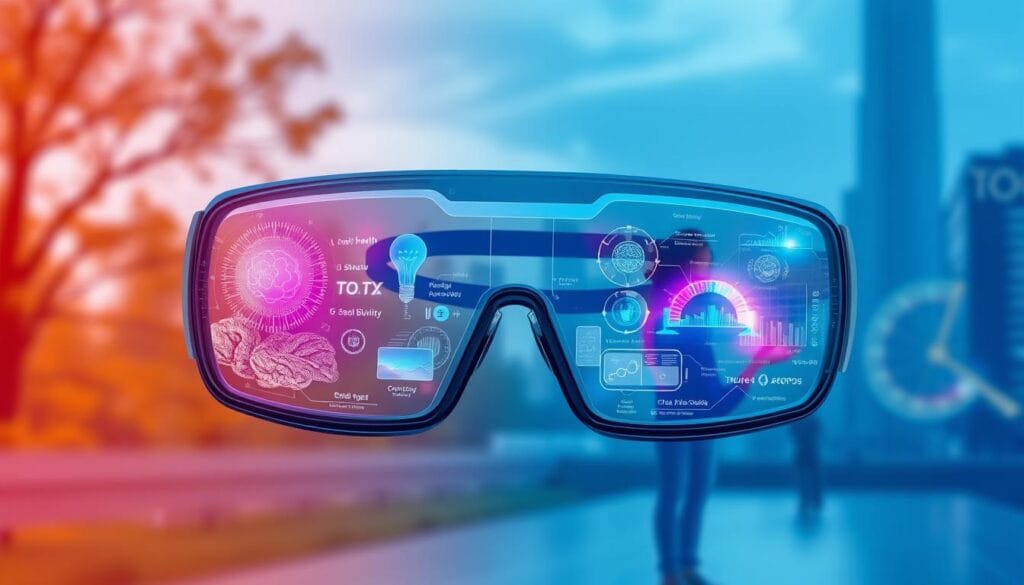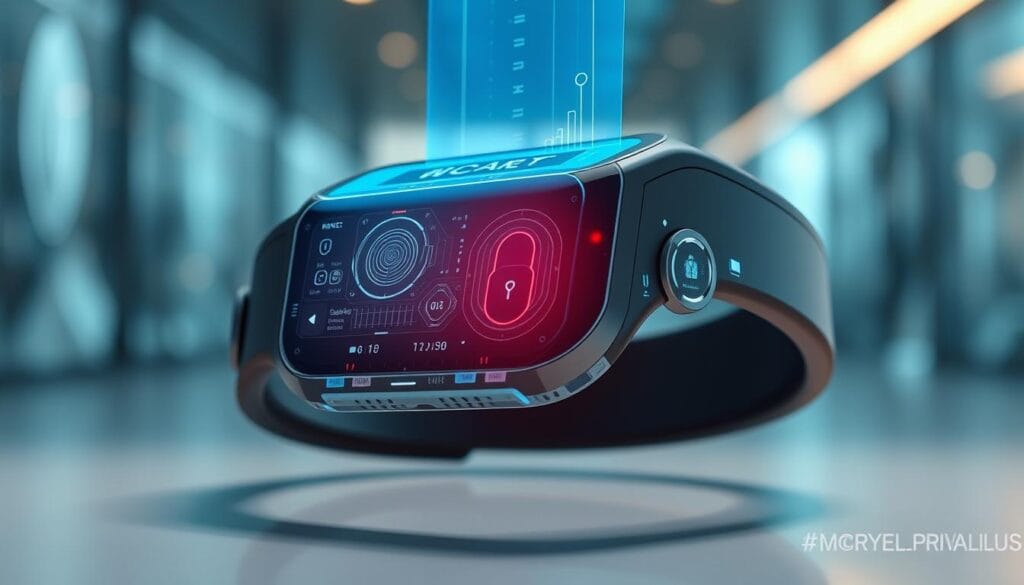Have you noticed how wearable devices have changed? They’re no longer just for tracking steps and heart rates. Now, they help with mental health, wellness, and even work productivity.
The wearable tech market is set to hit over $200 billion by 2025. It’s all about health monitoring now. These gadgets monitor more than just physical health. They monitor stress, sleep, and activity levels.
In the U.S., 79% of adults wear smartwatches or fitness trackers. This enables individuals to better control their health. Companies are using these tools to boost employee health and work performance.
Evolution of Wearable Technology in Modern Life
Wearable technology has grown a lot since the 1960s. Now, we have smart jewelry, industrial wearables, and biometric authentication wearables. These gadgets change how we keep track of our health, work better, and connect online.
From Simple Trackers to Smart Ecosystems
The early 2000s saw the start of wearable tech with fitness trackers like Fitbit and Nike+ FuelBand. They let us check our steps, heart rate, and more. This was the start of today’s smart systems.
Integrating AI with cutting-edge sensors
AI and advanced sensors have made wearables even better. For example, the Apple Watch Series 6 tracks sleep, blood oxygen, and heart rhythms. Assisting in improving our health comprehension.
Connected health devices are becoming more prevalent
The wearable tech market is expected to hit over $60 billion by 2025. This growth is thanks to connected health devices. Devices like the Polar H10 and Oura Ring are changing how we manage our health. They help us care for patients remotely.
| Device | Key Features | Application |
|---|---|---|
| Fitbit Charge 4 | Built-in GPS, 20+ goal-based exercise modes | Fitness and activity tracking |
| Whoop Strap 3.0 | Heart rate variability, sleep quality, recovery rate monitoring | Personalized performance and wellness insights |
| Apple Watch Series 6 | Blood oxygen level tracking, ECG monitoring | Holistic health and fitness management |
Wearable tech keeps getting better with AI and sensors. It’s changing how we manage our health and work. We’re entering a new era of connected devices and data.
Supervising and handling mental well-being
Wearable technology is changing how we manage mental health. Studies show that people using these devices are 40% more aware of their mood and stress. These devices can track signs of mental health, helping with depression and anxiety.
Wearables in mental health care offer new ways to monitor and treat. They help in early detection and tailor treatments. This could greatly improve mental health care, giving people tools to manage their well-being.
Depression affects over 264 million people worldwide, leading to 800,000 suicides each year. In the US, 7% of adults have depression every year. Children and women are more likely to experience it.
The need for mental health support has grown, especially with COVID-19. Wearables now help in managing mental health, not just physical health.
“Wearables hold promise for digital precision medicine in mental health, offering transformative possibilities in clinical practice.”
Digital biomarkers in mental health are captured through various sensors. Companies like Ellipsis Health and Affectiva are working on these. They aim to detect depression and emotional changes.
Wearables offer continuous monitoring of mental health. They provide real-time data, helping in managing anxiety and depression. Studies show they improve symptoms and quality of life.
The wearable tech market is quickly growing. Thanks to AI and miniaturization, mental health solutions are getting better. These tools can help people manage their mental health better, making care more accessible and effective.
Boosting Efficiency Using Intelligent Devices
Smart technology is revolutionizing our work processes. They help us manage time better, do tasks more efficiently, and talk to each other more easily. This enhances work efficiency and improves collaboration.
Workplace Integration Solutions
Smart devices range from simple fitness trackers to advanced gesture control interfaces and wearable cameras. They make work easier by letting us do things without using our hands. This saves time and lets us focus on important tasks.
Improving tasks and handling time
These devices use sensors and AI to understand how well we work. They track how we spend our time and give tips to work better. This helps us make smart choices and use our time wisely.
Communication Enhancement Features
Smartwatches and AR glasses change how we talk at work. They let us call hands-free, send messages quickly, and see important info right away. This makes work more connected and less interrupted.
Using smart devices at work makes us more productive and happy. As these tools get better, we’ll work smarter, make better choices, and have a better balance between work and life.
Wearable Technology Beyond Fitness: The New Frontier
Wearable technology is growing beyond just tracking fitness. Now, it’s used for mental health, improving work productivity, and for immersive experiences with augmented reality (AR) and smart textiles. These devices are changing how we manage our health and interact with computers every day.
AR glasses are revolutionizing our perception and engagement with the world. They add digital info and visuals to our surroundings, making it easy to access data without using our hands. AR glasses help us navigate and make decisions more easily.
Smart textiles are making technology part of our clothes and accessories. They can track health metrics like heart rate and skin temperature. This lets us take better care of our health through our daily wear.
These advanced wearables are making health management and computer interaction better. They help track mental health and boost work productivity. Wearable tech is now a key part of improving our lives, not just our fitness.

| Wearable Technology | Key Features | Applications |
|---|---|---|
| Augmented Reality Glasses |
|
|
| Smart Textiles |
|
|
As wearable tech keeps evolving, it’s set to change our lives in big ways. Nowadays, it’s more than just being in shape. It’s about better health, work, and how we use computers. The future of wearable tech is exciting, bringing us new experiences and ways to make decisions.
Advanced Healthcare Applications and Remote Monitoring
Wearable technology is changing healthcare, making new apps and remote monitoring possible. These health monitoring devices are changing how we care for patients. They let people play a bigger role in their health.
Continuous Health Data Collection
Wearable devices now collect lots of health data, like heart rate and sleep. This continuous health data collection lets doctors keep an eye on patients from afar. With these biometric authentication wearables, doctors can spot problems early and help patients sooner.
Early Detection and Prevention
Wearable devices help find health issues early, like heart problems or chronic diseases. They let people catch and prevent big health issues. This helps avoid serious problems and saves money for healthcare.
Integration with Healthcare Systems
Wearable tech working with healthcare systems is a big step forward. Biometric authentication wearables send patient data to health records. This lets doctors give better care and keeps patient info safe.
As wearable tech gets better, healthcare will see big improvements. Patients will get better care, and managing chronic diseases will get easier. Healthcare will become more personal and proactive.
Sleep Optimization and Recovery Tracking
As health monitoring devices and wearable technology beyond fitness grow, they’re key in tracking sleep and recovery. These devices monitor sleep patterns, giving users insights into their habits. They track duration, quality, and different stages of sleep.
Wearables help improve sleep hygiene and health by analyzing sleep data. They also track physical and mental recovery, which is great for athletes and those with stress or chronic conditions. This data helps optimize training, improve performance, and support wellness.
But, it’s crucial to remember that sleep trackers can be wrong. They might even lead to an unhealthy focus on sleep stats, called orthosomnia. It’s important to use sleep tracking wisely, aiming to improve sleep quality, not just track numbers.
| Feature | Benefits | Limitations |
|---|---|---|
| Sleep Monitoring |
|
|
| Recovery Tracking |
|
|
As wearable technology beyond fitness advances, it will offer better sleep and recovery tracking. With advanced sensors, AI, and personalized advice, users will get more help in improving their health and well-being.
Smart Clothing and Immersive Technologies
The rise of smart clothing and immersive tech is a big step forward in wearable tech. Smart textiles with sensors can track health metrics without extra devices. They monitor heart rate, body temperature, and muscle activity, giving a full picture of physical activity.
Augmented reality augmented reality glasses change how we work and play by adding digital info to the real world. They make tech feel like part of our daily lives. Immersive gaming accessories like haptic gloves and VR headsets make gaming more real and fun, changing how we enjoy digital content.
Innovation in Smart Fabrics
Sensors in fabrics let us track health during exercise without extra gadgets. They monitor heart rate, body temperature, and muscle activity. This gives a detailed look at how active we are.
Augmented Reality Integration
Augmented reality glasses, like the Ray-Ban | Meta Smart Glasses, give an immersive experience. They add digital info to our world, making tech a part of our daily lives.
Next-Generation Wearable Interfaces
Immersive gaming accessories like haptic gloves and VR headsets make gaming better. They offer new ways to enjoy digital content, changing how we work and play together.
These new smart clothes and tech are changing how we live. They make health tracking, work, and fun more seamless, blending tech into our daily routines.
Privacy and Security Considerations
The use of biometric authentication wearables and health monitoring devices is growing fast. This has made privacy and security very important. A survey showed that 80% of people worry about their data being handled by these devices.
These gadgets gather important health and personal information. This raises big questions about who owns this data, how it’s stored, and who it’s shared with.
To tackle these worries, new biometric features are being made to keep data safe in wearables. It’s important to have strong data protection and clear data policies. This helps keep users’ trust and ensures these devices are used ethically.
Groups like the Fairness, Accountability, and Transparency in Machine Learning (FAT/ML) are working hard. They aim to protect processes and define fairness in AI wearable tech.
Ethical design in wearables is about more than just keeping data safe. Designers can also focus on making devices inclusive and fair. They can add features that help with mental health and make sure these devices are made in a sustainable way.
By designing responsibly, wearables can help people, change markets, support sustainability, and bring communities together.
“Wearables, when designed ethically, can improve health and well-being, disrupt markets, empower individuals, promote sustainability, and foster collaboration within communities.”
As wearable tech keeps getting better, finding a balance between new tech and keeping user data safe is key. It’s important to be open, let users control their data, and understand the impact these devices have. This will help build trust and ensure biometric authentication wearables and health monitoring devices are developed responsibly.

Conclusion
Wearable technology has grown a lot since it first started. Now, it does more than just track fitness. It also helps with health, mental wellness, and boosts productivity. Thanks to AI, advanced sensors, and connected devices, managing health and work has changed a lot.
The market for wearables is expected to hit over $200 billion by 2025. This shows how much potential these devices have in changing healthcare, mental health, and our daily lives.
In many fields, wearables promise to make things safer, more efficient, and offer more choices. The future of wearables looks bright with new tech like virtual reality, better sensors, and AI. But, we must also focus on keeping our data safe and private.
Wearables are changing how we live and work. They offer health insights and tools to make us more productive. As these technologies keep evolving, the possibilities for how they can improve our lives are endless.
FAQ
What is the current and projected growth of the global wearable technology market?
How have wearable technologies expanded beyond basic fitness tracking?
What are the benefits of using wearables for mental health management?
How are smart devices being integrated into the workplace?
What are some of the emerging frontiers in wearable technology?
How are wearable technologies transforming healthcare?
What are the key features of wearable technology for sleep optimization and recovery tracking?
What are the emerging trends in smart clothing and immersive technologies?
What are the key privacy and security considerations for wearable technology?
Source Links
- https://9meters.com/technology/watches/future-trends-in-wearable-technology-beyond-smartwatches – Future Trends in Wearable Technology Beyond Smartwatches – 9meters
- https://www.linkedin.com/pulse/latest-wearable-technology-health-fitness-innovations-phcbc – The Latest in Wearable Technology: Health and Fitness Innovations
- https://opsmatters.com/posts/evolution-wearable-tech-health-and-fitness – The Evolution of Wearable Tech in Health and Fitness
- https://holoware.co/the-evolution-of-wearable-technology/ – The Evolution of Wearable Technology – Holoware
- https://pmc.ncbi.nlm.nih.gov/articles/PMC11374139/ – A Comprehensive Review on Harnessing Wearable Technology for Enhanced Depression Treatment
- https://www.feeltherapeutics.com/post/wearable-technology-in-mental-health – Digital Precision Mental Health: The Role of Wearable Technology in Objective Monitoring.
- https://psico-smart.com/en/blogs/blog-the-impact-of-wearable-technology-on-personal-health-monitoring-162704 – The Impact of Wearable Technology on Personal Health Monitoring
- https://psico-smart.com/en/blogs/blog-wearable-technology-trends-how-smart-devices-are-revolutionizing-wellness-166828 – How Smart Devices Are Revolutionizing Wellness
- https://wegile.com/insights/wearable-tech-integration-in-fitness-app.php – Wearable Tech Integration in Fitness Apps: 7 Key Benefits
- https://9meters.com/technology/the-future-of-wearables-exploring-next-generation-technological-innovations – The Future of Wearables: Exploring Next-Generation Technological Innovations – 9meters
- https://blog.wodify.com/post/the-rise-of-wearable-fitness-technology – The Rise of Wearable Fitness Technology | Wodify
- https://medium.com/@encata/the-future-of-wearable-technology-trends-and-possibilities-826bc05d7c60 – The Future of Wearable Technology: Trends and Possibilities
- https://kms-healthcare.com/blog/wearable-technology-in-healthcare/ – Wearable Technology in Healthcare and Its Benefits
- https://pmc.ncbi.nlm.nih.gov/articles/PMC11212841/ – A Comprehensive Review on Advancements in Wearable Technologies: Revolutionizing Cardiovascular Medicine
- https://topflightapps.com/ideas/wearable-technology-in-healthcare/ – Wearable Technology in Healthcare: The Future of Medical Devices
- https://wellbeingmagazine.com/the-rise-of-wearable-tech-in-the-fitness-industry-trends-to-watch/ – The Rise of Wearable Tech in the Fitness Industry: Trends to Watch – Wellbeing Magazine
- https://truesport.org/preparation-recovery/technology-optimize-athlete-sleep/ – How To Use Technology to Optimize Athlete Recovery and Sleep
- https://www.330trading.com/blogs/tech-meets-sweat-wearable-tech-integration-in-athleisure – Tech Meets Sweat: Wearable Tech Integration in Athleisure | 330 Trading
- https://www.ortmoragency.com/blog/wearable-ai – Beyond Smartwatches: The Next Wave of Wearable AI
- https://medium.com/lumen-by-ida-design/beyond-the-hype-4-ethical-considerations-for-wearable-technology-6f1588ac0e1e – Beyond the Hype: 4 Ethical Considerations for Wearable Technology
- https://blog.ipleaders.in/wearable-technology-and-privacy-concerns-all-you-need-to-know/ – Wearable technology and privacy concerns : all you need to know – iPleaders
- https://www.medivault.ai/post/wearables-and-healthcare-redefining-health-monitoring-beyond-basic-fitness – Redefining Health Monitoring Beyond Basic Fitness | Medivault
- https://foundersmag.com/wearable-technology-innovations/ – Wearable Technology Innovations: How Are They Revolutionizing Daily Life?
- https://poctinnovators.com/the-future-on-your-wrist-exploring-the-impact-and-evolution-of-wearable-technology/ – Exploring the Impact and Evolution of Wearable Technology – Point of Care Testing Innovators




